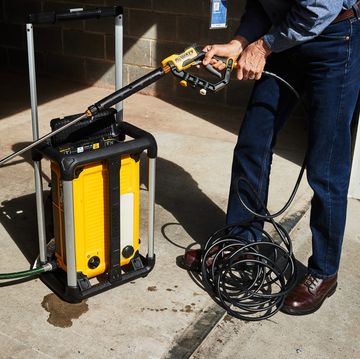KITCHEN SINKS:
2:48 || POISON PERFUME:
Drain odors are making your kitchen an unpleasant place in which to spend time.
THE QUICK FIX
Pour a cup of white vinegar down the drain, let it stand for 30 minutes, then rinse with hot water.
2:49 || SLIME TIME:
You're right in the middle of preparing that big Thanksgiving feast, when your kitchen sink chokes on all the grease that you've been allowing to go down the drain.
THE QUICK FIX
Use a heating pad wrapped around the drain trap (or a hair dryer if you're willing to hold it there) until the metal becomes hot. This will melt the grease and allow you to flush it away with a running stream of hot water.
2:50 || SMELL HOLE:
The odors wafting out of your garbage disposal are more fitting for a sewer than a kitchen sink.
THE QUICK FIX
Disposals can retain food bacteria in the blades, making for an olfactory nightmare. Clean out the unit with a cup of white vinegar followed by a flush of very hot water.
DISASTER PREVENTION:
5 simple steps to prevent drain clogs.
THE QUICK FIX
Stopping clogs is a battle fought on two fronts. First, you should be careful about what goes down the drain. Second, you need to take regular action to clear small deposits that inevitably form in any drain.
1. Use drain screens to keep hair, soap scum, and other solids from making their way into the drain.
2. Never pour grease down the drain, and clean greasy pots and pans as thoroughly as possible with a paper towel before cleaning in hot water in the sink.
3. Never dump chemicals such as paint or paint thinners down a drain--even a shower drain or utility sink.
4. Clean all your sink stoppers regularly.
5. Once a week (make it a regular part of your weekly cleaning schedule) pour boiling hot water down your drains.
BATHROOMS:
2:51 || SLOW MOTION:
Your bathroom sink is draining little but your patience.
THE QUICK FIX
55 The handy plunger is one of the best tools for a slow-moving drain. Fill the sink with a few inches of water to provide a good seal around the plunger. Next, stuff a wet rag into the overflow opening of the sink. Try to completely fill the opening so that you get a good seal. By blocking the opening, no air can reach the drain, which greatly increases the effectiveness of the plunger. Finally, plunge away.
2:52 || CLEAN OUT:
Your drain won't--and the plunger you have isn't strong enough.
THE QUICK FIX
In an emergency, you can use a wet/dry shop vacuum to help clear a clog. Put the mouth of the vacuum hose over the drain opening and seal around it with a wet cloth (also plug up any overflow holes). Turn the vacuum on and off quickly until the clog clears.
2:53 || STANDING WATER:
Soap scum and the residue of other body and hair products have packed your shower drain to capacity.
THE QUICK FIX
If simple plunging, hot water, or chemical drain cleaners don't work, you may need a more powerful ally. Run a garden hose in through a nearby window and secure it in the opening of the drain (drying the shower floor thoroughly and duct taping the hose securely in place is a good option). Once you're certain the hose has been sealed in the drain, turn on the spigot full force and it should blast the clog free.
SAFE AND SOUND:
Dangerous Additions: How not to unclog a toilet.
THE QUICK FIX
Trust us, nobody likes to plunge a toilet. But the frustration that comes from having a clog can lead to some inadvisable home remedies. Never put boiling water down a toilet. Although it seems like this might break up a clog, the water in your toilet is cold (in winter, it may be very cold) and the difference in temperature can lead to damage to your toilet or pipes. If for any reason you put bleach into the toilet, do not combine it with any other cleaner or chemical clog remover. The combination could create deadly chlorine gas. For most toilet clogs, the best answer is usually a mechanical one, such as a snake or-- sadly--the old-time plunger.
BASEMENTS:
2:54 || UNPLANNED POOL:
A big rain has flooded your basement. And since it knocked out the power too, your usually reliable sump pump won't pump.
THE QUICK FIX
If you live on a slope, try making a siphon. First, fill a garden hose with water from the outside spigot. Seal one end with your thumb and have a friend seal the other. Place one end through the cellar window and into the standing water. Then, have your friend carry the other end as far downhill as possible (the outlet has to be below the intake). Release your thumbs and let gravity do the rest.
2:55 || TRAPPED BELOW:
The water in the trap of your basementfloor drain dried up, and now your cellar smells vaguely of nasty, nasty things.
THE QUICK FIX
Pour nontoxic plumbing antifreeze down the drain to fill the trap. You can use water in a pinch, but it evaporates faster than antifreeze, so you'll need to repeat the process more often. If you have pets in your home, make sure to block access to the area.













